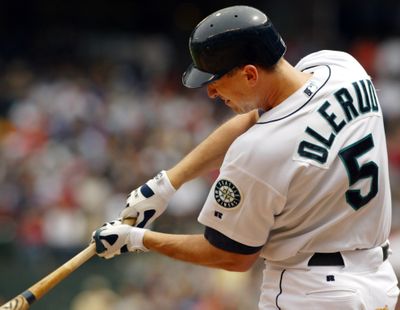Olerud’s baseball career nothing short of amazing

To call John Olerud’s baseball life charmed is no first baseman’s stretch.
Let’s see – two World Series rings, possibly the greatest college season in history, an American League batting title, membership in the exclusive straight-to-the-majors club and a shotgun seat on the Seattle Mariners’ magic-carpet-ride 116-victory season.
And mixed in there somewhere: a brain aneurysm.
OK, so sometimes charm takes a holiday. Or a U-turn toward the scary/tragic.
This, of course, occurred during his junior year at Washington State University, after he’d Roy Hobbsed his way into the national baseball consciousness. First there were the headaches and then the collapse during practice, then the swift diagnosis and surgery, Olerud the whole time cocooned in the youthful ignorance that “there couldn’t be anything wrong with me,” while his father, John, a doctor, sweated out the reality.
“I know my dad felt a lot better when they did find the aneurysm,” Olerud recalled, “just because he knew too many of the other bad things it could have been. I was more like, ‘How can you feel good they found something? This is not good.’ ”
The batting helmet he wore even in the field from that point on became his trademark – along with a batting stroke straight off the cane and an easy grace afield – but in time the reason behind the precaution was mostly forgotten, as were lesser hiccups along the way.
But the fact is, the baseball career that will usher Olerud into the Inland Northwest Sports Hall of Fame today at the Spokane Arena, charmed as it was, included some challenges, too.
For instance, barely three years after winning that batting championship and the second of two World Series rings with Toronto, Olerud was virtually given away in a trade to the New York Mets – the Blue Jays threw in some cash, too, to get one Robert Person, who research reveals to have been a pitcher.
“New York was a place I was scared to death to go to every time I played there with the Jays,” he confessed. “To sort of survive and find out it wasn’t as bad as I thought was great, and especially to find a batting coach, Tom Robson, who helped me get things turned around.”
That career revival made him a prime free-agent target for the Mariners, who brought him home in 2000. That was a stretch of immense satisfaction, but it also meant that when his career did begin to wind down – and the Mariners fortunes took an ugly tumble – that the separation would be painful.
There are few things as awkward as a mid-season release of a hometown hero. Few could have handled it as gracefully as Olerud.
And yet that always extended to his successes, as well.
For example, he deflected any hoo-hah about being one of just 21 players in the draft era who by-passed the minor leagues and debuted in the bigs.
“They had me as part of the September callup – and then they said I’d spend the first half of the next year in Triple-A,” he said. “They’re trying to get me to sign and so they’re giving me the best-case scenario. But the following year was the lockout and they expand the rosters to 27, and things sort of worked out.”
It’s his Cougars days that will largely be recalled today, in particular his splendiferous 1988 sophomore season when he was college baseball’s player of the year. Sometimes statistics are the least of it, but not in this case. As a hitter, Olerud batted .464 with 23 home runs and 81 RBIs; as a pitcher, he was merely 15-0. That made him a consensus All-American at two positions.
“The thing that doesn’t get mentioned is that we had such a strong team, there wasn’t much pressure on the pitchers,” Olerud said. “You could really be aggressive and go after guys. You didn’t have to be perfect.”
But he pretty much was.
“Sure, I knew the type of year I was having,” he said, “but what was fun was putting on the uniform and walking to the ballpark. There was a lot of pride in that.”
That’s always where the real charm is.